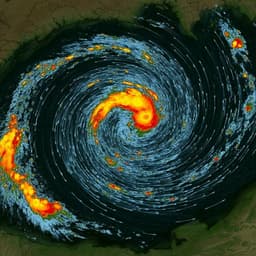
Earth Sciences
East Gobi megalake systems reveal East Asian Monsoon dynamics over the last interglacial-glacial cycle
H. Li, X. Yang, et al.
Discover the intriguing paleohydrology of the East Gobi Desert, revealing expansive paleolakes and climatic shifts since the last interglacial. This research, conducted by Hongwei Li, Xiaoping Yang, Louis Anthony Scuderi, and colleagues, highlights the wet phases and their impact on East Asia's climate dynamics.
~3 min • Beginner • English
Introduction
The study addresses long-standing uncertainty about when and how strongly wet phases impacted the East Asian deserts, particularly the East Gobi Desert, since the last interglacial. Given deserts' high sensitivity to climate variability and their role as major dust sources affecting regional to global climate, reconstructing their environmental history is crucial. The East Gobi Desert lies at the northern limit of the East Asian Summer Monsoon (EASM) and near the Siberian High that drives the East Asian Winter Monsoon (EAWM), making it a key region to decipher monsoon dynamics. Despite the Gobi landscape forming by ~2.6 Ma, pre-Holocene records are sparse due to deflation. The timing and magnitude of pre-Holocene wet phases, their relationship to EASM variability, and the Holocene hydroclimate evolution in the East Gobi remain disputed. This study aims to reconstruct hydrological and climatic conditions over the last ~130 ka by identifying paleodrainage and lake systems and establishing robust chronologies, thereby clarifying monsoon behavior and its implications for dust emission.
Literature Review
Prior evidence from aeolian sands and lacustrine deposits in the Gobi is predominantly Holocene in age due to deflation of older strata. Conflicting records exist for MIS 3: shoreline deposits from Huangqihai Lake imply dry conditions with loess deposition, while Wulagai Lake records suggest warm, humid conditions. The Holocene onset of humidity is also debated, with many studies pointing to ~8 ka, while others argue for an earlier start correlated with southern Chinese speleothem δ18O. Broader regional work has reassigned many North China and Tibetan Plateau lake highstands previously dated to MIS 3 by radiocarbon to MIS 5 using luminescence methods, highlighting radiocarbon underestimation for older samples. There is also a recognized need to consider geomorphological controls on hydrology in paleoclimate reconstructions. These discrepancies motivate a comprehensive, geomorphology-grounded and multi-method dated reconstruction for the East Gobi.
Methodology
- Geomorphological mapping: Used multiple DEM datasets (GMTED2010 ~1 km, SRTM 90 m v4.1, ALOS World 3D 30 m) and satellite imagery (Sentinel-2A, Google Earth) to delineate paleolake shorelines, spits, barrier systems, terraces, fan deltas, and inter-basin paleochannels across four sub-basins (eastern EB, southern SB, northern NB, southwestern SWB). Longitudinal profiles of channels constrained paleolake levels.
- Field sedimentology: Logged and sampled shoreline and beach deposits; identified lacustrine sands and gravels with symmetrical wave ripples and collected aquatic mollusk shells (Corbiculidae) from SB and SWB. Noted aeolian sand and sandy loess capping shoreline deposits indicating post-lake desiccation.
- Chronology: Applied multiple dating methods with cross-validation and assessment of each method's limitations:
• Radiocarbon (AMS) dating of Corbicula shells (noting potential modern carbon contamination and treating >40 ka ages as minimum estimates).
• U-series (U–Th) dating of shells and pedogenic carbonate coatings on shoreline gravels. Considered open-system behavior in shells due to recrystallization; used coatings (closed-system) to derive minimum ages for shoreline formation.
• Luminescence dating: Quartz OSL for shoreline and aeolian sediments, with finite ages only reported where De ≤150 Gy; K-feldspar post-IR IRSL (PIRIR200,290) for older, stable signals (De often 400–470 Gy) to better constrain MIS 5 ages. Dose rate determinations via ICP-MS/OES (Xi’an lab) and high-resolution gamma spectrometry (DTU NLLD); dose recovery tests performed.
- Hydrologic modeling: Built a steady-state water balance model for paleolakes to estimate required mean annual precipitation during MIS 5 and the mid-Holocene, incorporating lake area, catchment area, lake evaporation (tested 900–1100 mm/yr), runoff coefficients derived from an empirical precipitation–runoff relationship based on 92 North China catchments, and potential outflow through mapped meander channels. Estimated paleochannel discharge from meander geometry to bracket outflow uncertainty.
- Tectonic assessment: Evaluated tectonic stability via literature (GPS, earthquake records) and consistency of shoreline elevations over >200 km; found no evidence of tectonic deformation affecting reconstructions.
- Lake extent reconstruction: Computed paleolake areas, depths, and volumes at mapped highstands using ALOS 30 m DEMs.
Key Findings
- Geomorphology and lake levels:
• Four sub-basins identified (EB, SB, NB, SWB). Clear shoreline landforms (spits, barriers, terraces) and inter-basin channels demonstrate an interconnected megalake system.
• SB: Highest paleolake level ~1025 m a.s.l.; additional terrace at ~1008 m.
• EB: Lake level >1040 m, inferred from lacustrine/fluvial deposits and paleochannel geometry.
• NB and SWB: Highest paleolake level ~990 m a.s.l.; evidence includes cuspate shoreforms, barrier systems, fan deltas with slope breaks at 990 m; NB had a small outflow channel with max elevation ~990 m.
• Inter-basin connections: Overflow channels connect SB→NB (highest elevation ~1025 m) and NB↔SWB (~984–990 m thresholds), indicating system integration at highstands.
- Chronology:
• Radiocarbon on shells yielded finite ages ~42–46 14C kyr BP but considered minimum ages; older samples exceeded dating limit.
• U–Th on shells commonly overestimated due to open-system behavior; paired carbonate coatings provide younger bounds. Combined shell and coating ages constrain megalake formation to MIS 5; oldest coating ages 76–73 ka give minimum ages for shoreline formation.
• Luminescence: Quartz OSL ages for SB shorelines (sections C: 81–87 ka finite; D minimum ages) indicate MIS 5 deposition. K-feldspar post-IR IRSL across SB, NB, SWB yields 92±5 to 141±8 ka, firmly placing shoreline formation in MIS 5.
- Lake extent and volumes:
• At MIS 5 maximum, paleolakes covered ~15,500 km², with maximum depth ~90 m and volume ~489 km³.
• Rivers reactivated during humid phases; NB likely fed via SB and SWB through inter-lake channels.
• Mid-Holocene highstand in SB at ~1008 m (17 m below SB overflow threshold), dated by OSL to ~6.7 ka; mid-Holocene lakes were much smaller than MIS 5.
- Climate inferences:
• Presence and abundance of freshwater mollusks (Corbicula fluminea; Parafossarulus striatulus) indicate low salinity and much warmer winters during MIS 5; coldest-month mean temperatures inferred to be >10 °C warmer than present, enabling a northward shift of thermal limits by ~400–900 km.
• Water balance modeling indicates required precipitation increases of ~120–150% (MIS 5) and ~80–110% (mid-Holocene) relative to modern (~230 mm/yr), with limited sensitivity to NB meander outflow uncertainty.
• The humid climate limit (~800 mm/yr isohyet) likely shifted ~1000 km northward during MIS 5, to the southern fringe of the Gobi.
• Evidence suggests EASM was much weaker during MIS 3 in the East Gobi, with MIS 2–4 arid to semi-arid conditions indicated by carbonate precipitates and lack of highstands.
- Dust implications:
• A dustier MIS 4 across East Asia and the North Pacific is attributed to enhanced dust supply after desiccation of the extensive MIS 5 fluvial-lacustrine system; MIS 2 had stronger winds but lower supply, explaining coarser loess but lower dust flux compared to MIS 4.
- Regional coherence and contrasts:
• East Gobi hydrology aligns with insolation and marine δ18O pacing and with Chinese Loess Plateau and Lake Baikal records, but diverges from southern China speleothem δ18O in capturing stronger MIS 5 wetness than mid-Holocene at the northern EASM margin.
Discussion
The integrated geomorphologic, stratigraphic, and multi-method chronological evidence demonstrates that the East Gobi Desert hosted a large, interconnected megalake system during MIS 5, with a smaller resurgence in the mid-Holocene. These hydrologic reconstructions directly reflect precipitation changes at the northern limit of the EASM. The robust MIS 5 highstands and modeled precipitation increases imply a substantially strengthened and northward-expanded EASM relative to today, whereas the absence of MIS 3 highstands indicates that, contrary to some cave-based interpretations, the EASM was likely weaker during MIS 3 in this interior northern region.
The widespread freshwater mollusk assemblages, combined with modern ecological constraints, point to markedly warmer winters (~10 °C above present) during MIS 5, consistent with a weakened EAWM and expanded EASM influence into mid-latitudes. This winter warming signal suggests that mid-latitude East Asia experienced conditions differing from present warming seasonality and may reconcile with other regional marine records.
The post-MIS 5 desiccation of extensive lake and fluvial systems likely enhanced dust availability, providing a mechanistic explanation for the observed regional and Pacific records of elevated dust flux during MIS 4 despite colder MIS 2 winds being stronger. Thus, the study links monsoon-driven hydrologic states to downstream dust cycle dynamics.
Finally, discrepancies between East Gobi hydrologic reconstructions and southern China speleothem δ18O highlight spatial heterogeneity and a longitudinal gradient in monsoon rainfall during interglacials, underscoring that cave records from the south may not fully capture precipitation variability at the northern monsoon margin.
Conclusion
This work reconstructs an MIS 5 megalake system (~15,500 km², up to ~90 m deep, ~489 km³) across the East Gobi Desert and a smaller mid-Holocene lake expansion, providing direct evidence for significantly wetter conditions linked to an intensified and poleward-extended EASM. Multi-proxy dating (luminescence, U–Th coatings, radiocarbon minima) anchors these hydrologic phases to MIS 5 and mid-Holocene. The findings imply much warmer winters during MIS 5 (suggesting weaker EAWM), a likely weaker EASM during MIS 3 at the northern margin, and offer a process-based explanation for a dustier MIS 4 due to elevated dust supply from desiccated MIS 5 lakebeds and fluvial deposits. The study refines the spatiotemporal dynamics of East Asian monsoons and emphasizes the importance of geomorphologic-hydrologic archives at the monsoon margin.
Future research should include detailed provenance studies to quantify the dust contributions from the East Gobi to East Asia and the North Pacific, tighter chronological constraints on paleochannel incision and outflow timing, improved groundwater flux estimates in water balance models, and higher-resolution mapping to resolve sub-basin hydrologic connectivity through time.
Limitations
- Radiocarbon dating of shells older than ~40 ka is prone to underestimation due to modern carbon contamination; such ages were treated as minima.
- U–Th ages on shells are susceptible to open-system behavior and recrystallization, likely overestimating true ages; shell carbonate coatings provide more reliable minimum bounds but still reflect a lag after deposition.
- Quartz OSL ages with De > ~150 Gy can underestimate burial ages; finite ages were only reported for De ≤150 Gy, with older samples constrained by K-feldspar post-IR IRSL.
- The age of the NB outflow meander is not directly dated; precipitation estimates consider scenarios with and without outflow and use discharge inferred from meander geometry, introducing uncertainty (though with limited impact on modeled precipitation).
- Groundwater discharge was assumed negligible in the water balance model; unquantified groundwater flux could affect precipitation estimates.
- Affiliations for some co-authors (superscripts 8 and 9) are not provided in the available text.
- Dust provenance was not directly quantified; interpretations of MIS 4 dustiness rely on process reasoning and regional correlations, pending provenance confirmation.
Related Publications
Explore these studies to deepen your understanding of the subject.







